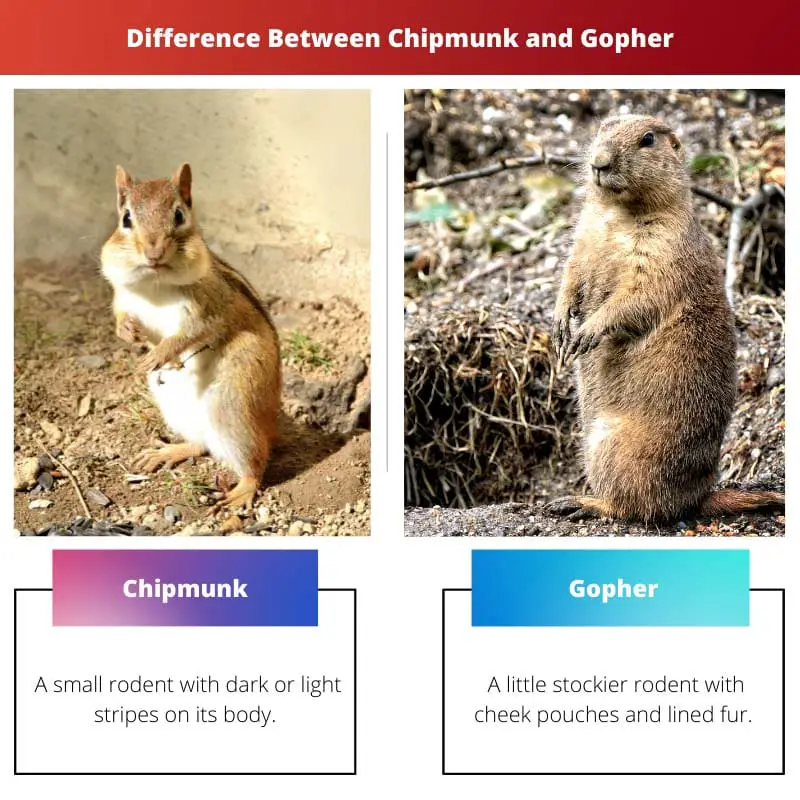Our world displays significant biodiversity. We have several varieties of flora and fauna. They are classified into division, kingdom, class, order, family, species, and genus. Mammals, reptiles, amphibians, invertebrates, etc., are different kinds of animals.
Each animal has characteristics that differentiate it from others. Chipmunks and gophers are types of rodents. Rodents are mammals and prove to be the largest group of mammals.
They are known for their growing incisors. Rodents are found in almost all habitats around the world except New Zealand and a few other ocean islands. Mice, squirrels, beavers, hamsters, rabbits, etc., are a few examples of rodents.
Key Takeaways
- Chipmunks are small, striped rodents that belong to the squirrel family.
- Gophers are larger, burrowing rodents that belong to the family Geomyidae.
- Chipmunks have stripes on their faces and bodies, while gophers do not have stripes and have a more cylindrical body shape.
Chipmunk vs Gopher
Chipmunks are members of the squirrel family, have bushy tails, are known for their distinctive stripes on their backs, and are diurnal, meaning they are active during the day. Gophers belong to the family Geomyidae, have shorter, hairless tails, have a solid brown or grey color, and are nocturnal.

Chipmunk is a rodent that belongs to the Sciuridae family and is small in size, has dark or light stripes on its body, with a long bushy tail. They dig holes in the ground and hence are called burrowing rodents.
They are known to create a small hole in their entrance. Chipmunks are active during the day and also sometimes in the dark. They are known to be very vocal as they make high-pitched chirps.
Gophers are rodents that belong to the Geomyidae family. They are known to have stockier bodies with check pouches and lined fur, black, brown, or gray fur.
Gophers are burrowing rodents as they create holes in the ground; they are known to create a honeycomb pattern in their hole. They are only active during the day and rarely make any sound. They are active throughout the year and do not hibernate.
Comparison Table
| Parameters of Comparison | Chipmunk | Gopher |
|---|---|---|
| Definition | A small rodent with dark or light stripes on its body | A little stockier rodent with cheek pouches and lined fur. |
| Family | Family Sciuridae | Family Geomyidae |
| Native to | Asia and North America | Central and North America |
| Burrow type | A small hole in their burrow entrance | Creates a pattern like a honeycomb. |
| Vocalization | Vocal animals; make a high-chirping sound. | Not very vocal, as they rarely make any sound. |
| Active During | Active during the day and sometimes in the dark as well and hibernate during the winters | Only active during the day and do not hibernate. |
| Food Habits | Omnivore | Herbivore |
What is Chipmunk?
Chipmunks are rodents that are a type of mammals; Rodents are the largest group of mammals. Chipmunks belong to the Sciuridae family, kingdom Animalia, and Phylum chordate.
Chipmunks may be classified and have adopted their genera – Tamias striatus (eastern chipmunk), Eutamaias sibiricus (Siberian chipmunk), and Neotamias minimus (least chipmunk).
It was originally spelled as ‘chitimunk’ from native Ottawa, derived from the word ‘jidmoonh,’ which means ‘red squirrel’ or literally “one who descends trees headlong,’ but later it was called chipmunk. There are nearly 25 species of chipmunks that have been identified.
They are small and have dark or light stripes on their body, a bushy tail, and stubby legs. The color of the stripes can be brown, black, or white as well. They are native to Asia and North America.
The eastern chipmunk is considered to be the biggest chipmunk. Chipmunks are called burrowing animals as they dig small holes in the land; they also build their nests on trees sometimes.
They are active during the day and dusk and hibernate during the winter (western chipmunks do not hibernate). They almost look dead, and their heartbeat drops during hibernation. They stuff extra food in their pouches in their cheeks and their burrows.
Chipmunks are known to be social animals and are omnivorous. They make high-pitched chirps (vocal animals). It is said that they give birth once or twice per year; matting happens in early spring and second in early summer, whereas western chipmunks breed once a year.
Though small, they are said to help and contribute to the forest ecosystem. Their life span is three years, but few have been observed living for nine years (in captivity).

What is Gopher?
Gophers are rodents that belong to the mammalian class. Rodents are the largest group of mammals. Gophers belong to the Geomyidae family. They are part of the Animalia kingdom and phylum chordate.
There are almost 35 species of gophers; native to Central and North America. They are also known as pocket gophers. There are three categories that gophers can be divided into – Thomomys (western pocket gophers), Geomys (eastern pocket gophers), and pappogeomys.
Gophers are small, furry animals with stockier bodies. It has fur lining and cheek pockets; they can be black, brown, or gray. Gophers have tiny small eyes.
They are called burrowing rodents as they are known for their tunneling activities; they build a hole in the pattern of a honeycomb, and their tunnels are shallow for forages. Gophers are not very vocal.
They rarely make any sounds. They are active only during the day and throughout the year; they do not hibernate. It is not a very social animal but is known for sharing its burrows with other creatures.
Gophers are herbivores that like consuming roots, tubes, and also the top portion of small plants. The male gophers are said to be larger (double the weight) than the female.
They can live up to three years, but the maximum is considered to be five years. Gophers give birth three or more times per year.

Main Differences Between Chipmunk and Gopher
- A chipmunk is a small rodent with dark or light stripes on its body, whereas a gopher is a little stockier rodent with cheek pouches and lined fur.
- Chipmunk is from Family Sciuridae, whereas gopher is from the family Geomyidae.
- Chipmunk is native to Asia and North America, whereas gopher is native to Central and North America.
- Chipmunk builds small hole in their burrow entrance, whereas gopher creates a pattern like a honeycomb.
- Chipmunks are vocal animals; they make a high-chirping sound, whereas gophers are not very vocal, as they rarely make any sound.
- Chipmunks are active during the day and sometimes in the dark as well and hibernate during the winter, whereas gophers are only active during the day and do not hibernate.
- Chipmunks are omnivores, whereas gophers are herbivores.

- https://esajournals.onlinelibrary.wiley.com/doi/abs/10.2307/1936586
- https://www.sciencedirect.com/science/article/pii/S0031018205007169

The comparison between chipmunks and gophers, coupled with the detailed descriptions of their features and behaviors, enriches our understanding of these fascinating rodent species.
I fully agree. The article’s thorough examination of chipmunks and gophers broadens our knowledge of their ecological significance and evolutionary adaptations.
Absolutely, the comprehensive overview of chipmunks and gophers enhances our appreciation of the diverse traits and behaviors exhibited by these rodent species.
The detailed description of chipmunks and gophers, from their physical appearance to their behavioral patterns, contributes to a comprehensive understanding of these small mammals.
The detailed insights into the classification, characteristics, and behaviors of chipmunks and gophers provide a valuable perspective on their ecological roles and evolutionary adaptations.
I couldn’t agree more. The article’s comprehensive coverage of chipmunks and gophers underscores their importance in the natural world and their unique ecological contributions.
The information about the vocalization and burrow types of chipmunks and gophers is particularly intriguing. It’s great to have a clear understanding of their behavior and habits in different environments.
Absolutely, understanding their vocalization patterns and burrowing habits provides valuable insights into their survival mechanisms and interaction with their surroundings.
The article provides a comprehensive overview of different types of rodents, such as chipmunks and gophers, including their characteristics, habitats, and behaviors. It’s interesting to learn about the distinctions between these animals and their impact on the ecosystem.
I agree. The detailed comparison table helps to highlight the differences between chipmunks and gophers, making it easier to understand their unique traits.
The taxonomy and classification of chipmunks and gophers are well-explained, shedding light on their evolutionary history and genetic diversity.
The article presents a thorough analysis of chipmunks and gophers, highlighting their distinct characteristics and the role they play in their respective habitats.
Absolutely, the detailed exploration of their behaviors and environmental adaptations provides valuable insights into the ecological dynamics involving chipmunks and gophers.
The article offers a comprehensive analysis of chipmunks and gophers, from their physical characteristics to their role in the ecosystem. It’s fascinating to learn about the nuances of these rodent species.
Absolutely, the in-depth exploration of their ecological significance enhances our appreciation for the diversity of rodent species.
I couldn’t agree more. Their unique features and environmental adaptations make chipmunks and gophers truly remarkable creatures.
The detailed comparison of chipmunks and gophers serves as an excellent educational resource, offering valuable insights into the distinguishing features and behaviors of these rodent species.
Absolutely, the article’s nuanced exploration of chipmunks and gophers enhances our understanding of their ecological significance and behavioral adaptations.
The comparison between chipmunks and gophers, including their anatomy, behavior, and food habits, offers a valuable insight into the distinctive traits of these rodent species.
I completely agree. The article’s detailed comparison table effectively showcases the differences between chipmunks and gophers, enriching our understanding of their unique characteristics.
Indeed, the comprehensive comparison provides a holistic view of chipmunks and gophers, emphasizing their ecological importance and diverse adaptations.